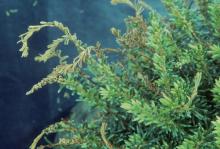Cause The fungus-like microorganism Phytophthora cinnamomi has been reported and found frequently in Oregon. Waterlogged soils and warm temperatures favor P. cinnamomi. It survives unfavorable periods in soil and infected plant debris. Under favorable conditions, spores germinate and infect roots. After infection, the microorganism spreads mainly in the inner bark tissues of the root and stems. Several spores can persist for several years. Movement of infected plants and/or soil can spread the organism.
Symptoms Leaves may turn grayish and/or the entire top of the plant wilts. The vascular cambium becomes dark or cinnamon-brown and there may be a sharp line between diseases and healthy root tissue. The rot is form until other microbes colonize the tissue. Roots become rotted, and the entire plant eventually dies.
Cultural control
- Provide good water drainage around roots.
- Do not overwater.
- Most species and cultivars need acid soil conditions.
- Use clean potting media.
- Avoid reusing pots from a previous crop for propagation. If pots must be reused then wash off all debris and soak in a sanitizing solution or treat with aerated steam for 30 min.
- Isolate new plants for a time before planting among other heaths.
Chemical control No chemicals are specifically registered, but Aliette and other Group P7 fungicides and/or Subdue (Group 4 fungicide) may be effective. Try on a few plants first before widespread use. Resistance to Group 4 fungicides is possible so tank-mix or alternate materials just in case.
Reference Casonato, S.G., Manning, M.A., Rheinlander, P.A., and Fullerton, R.A. 2008. Control of Phytophthora cinnamomi in Erica sessiliflora and Erica davisii. In The New Zealand Plant Protection Society 61st Annual Conference, Copthorne Hotel, Paihia, Bay of Islands, New Zealand, 12-14 August 2008. 61:86-90.



